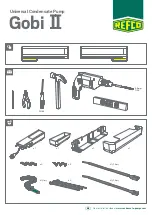
12
TROUBLE SHOOTING GUIDES
General Refrigeration Circuit
SYMPTOM
POSSIBLE CAUSE
1. Power off, loose electrical connections or fuse open.
2. Compressor contactor not closing.
3. Internal compressor thermal overload open.
4. Compressor defective.
5. High or low pressure switch open or defective.
6. Oil pressure control open or defective.
1. Low refrigerant charge
2. Airflow restricted.
3. Restriction in liquid line.
4. Defective low pressure switch.
1. Refrigerant overcharge.
2. Condenser fan control has incorrect setting.
3. Fan motor defective.
4. Condenser coil inlet obstructed or dirty.
5. Air or non-condensables in system.
6. Defective high pressure switch.
7. Restriction in discharge or liquid line.
1. Low voltage.
2. Sustained high discharge pressure.
3. High suction and discharge pressures.
4. Defective compressor overload.
5. Defective run capacitor.
6. Improper refrigerant charge.
7. Bearings or pistons too tight.
8. Allow time for compressor to cool.
1. Low oil level.
2. Defective oil pump.
3. Defective control.
4. Liquid refrigerant is entering crankcase.
1. Scroll compressors are rotation sensitive.
2. Refrigerant overcharge.
3. Excessive or insufficient oil in compressor
3. Check oil level in hermetic compressors. Check total e
crankcase.
4. Liquid floodback.
5. Tubing rattle.
6. Compressor defective.
4. Compressor will be wet. Check crankcase heater or cause for liquid feedback.
6. Check internal parts (semi-herm.)
1. Reverse wiring at disconnect switch, recheck for correct evaporator blower rotation.
2. Check pressures and subcooling.
4. Check TXV setting. Check for refrigerant overcharge. oil as recommended.
5. Dampen tubing vibration by taping or clamping. Bend tubing away from contact where possible.
8. Check dome temperature of the compressor.
1. Check crankcase sightglass - add oil to bring level to midway in sightglass.
2. Check oil pump.
3. Check oil failure control for calibration.
4. Allow compressor to cool for two hours if compressor is hot. Recheck for open circuit.
5. Check run capacitor for compressor and fan motor.
6. Check subcooling.
7. Check for low oil level.
7. Check discharge and liquid line pressures, check TXV.
1. Check voltage.
2. Check running amperage and conditions described under “high discharge pressure.”
3. Check TXV setting, check for air in system.
3. Check fan motor.
4. Check coil and inlet clearances and for possible air recirculation.
5. Check high side equalized pressure reading with equivalent outdoor temperature.
6. Check calibration of switch.
5. Check calibration of high or low pressure switch, re-calibrate or replace.
4. Check calibration of switch.
1. Check pressures, charge by sub cooling.
2. Check calibration of low ambient control.
1. Check sightglass and check pressures.
2. Check for dirty evaporator coil, dirty filters, dampers closed, iced evaporator, proper belt
adjustment, proper motor amps, duct design
3. Check head pressure, check and adjust TXV if not functioning properly, check pressure drop
across filter drier.
6. Check oil failure control. See oil failure control below.
1. Check disconnect switch, fuses and wiring. Replace parts or repair as necessary.
REMEDY
3. If compressor is hot, allow 2 hours to cool. See thermal overload below.
4. Check compressor for electrical failure. Compressor may be seized, check for L.R.A.
2. Check voltage to contactor coil, transformer, slave relay, system. Replace parts as necessary.
E. Compressor cuts out on oil failure
control (semi-herm.)
F. Noisy compressor.
A.Compressor will not start
B.Compressor starts but cuts out on
low pressure switch.
C. Compressor starts but cuts out on
high pressure switch.
D. Compressor cuts out on thermal
overload.
Содержание B
Страница 19: ...19 ...





































